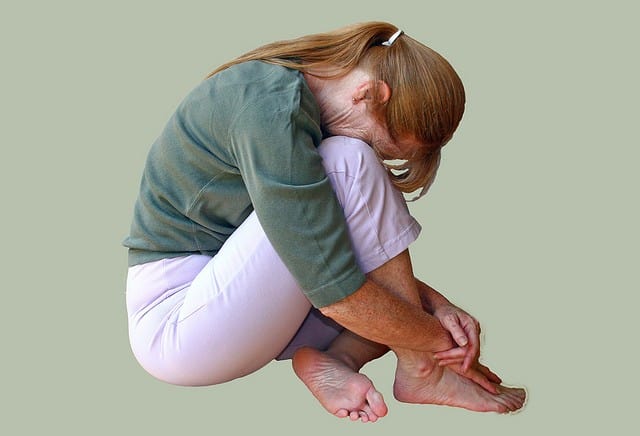Do you know how to sit, without pain, at your desk, at home, or…wherever?
Most people think they need expensive ergonomic equipment to have proper posture when sitting down. But you don’t need that, if you know how to sit the right way, by arranging your bones for optimal support of an aligned spine.
How can you do it? Think back to when you were a baby…
What Babies Can Teach us About Posture
Babies discover how to sit up all on their own. Some parents might encourage them by propping them up, but ultimately, learning how to sit upright can only be an inside job. Babies must find the vertical axis of gravity within themselves, that invisible “plumb line” along which they align their spines.
As if that weren’t challenging enough, they also have to figure out how to sit while balancing a heavy bowling ball-like head on top of the spine. None of this would be possible were it not for a large peculiar-looking bone called the pelvis.
While babies remain clueless about any concept of an aligned pelvis or any other anatomical feature, when they are able to successfully rest their weight on the pubis ramus at the front of the sit bones (ischial tuberosities) they are finally able to sit up without falling over.
How to Sit…the Right Way
Step 1: Establish your solid seat on an anchored pelvis.
Here’s a quick lesson in how to “park your pelvis” like a baby. Sit on a flat surface with both feet flat on the floor. Lean forward a bit and slightly to the left, and then slide your right hand under your right buttock, palm up, and then rest your weight on your hand. Roll around a bit until you feel a hard knob-like bone. Keep trying until you find it. This is your sit bone, and you have two of them, one on each side.
Lean forward again and slightly to the left, but this time simply “walk” your sit bone further back on the surface of the seat, taking care to rest your weight as much as possible on the front edge of the “knob.” Repeat this to the left side as well. Bring your torso up to vertical. If this causes your lower back to arch, we’ll be addressing this in a moment, so hang in there—unless you are feeling pain, in which case read through all the steps before proceeding.
Congratulations! You’ve now learned how to sit with a solid foundation for your skeleton. Like any architectural structure, we must start with the foundation, and then, and only then, can we begin to build our structure from the ground up.
Step 2: Exhale and Relax Your Belly
Really? Relax my belly while I’m trying to hold myself up straight?
Here’s your chance to get rid of any excess tension in your body. With the support of a well-planted pelvis, it’s now safe to relax without collapsing—so go ahead, the next time you exhale, let all that unnecessary tension just drop away.
Step 3: Release Your Chest Downward as Your Back Rises Up Behind You
This may seem counter-intuitive and perhaps a little slouchy at first, but let your chest settle down as your lower, middle and upper back rise upward. Keep your chest down, as the back of your armpits climb up to the sky, elongating your back and both sides of your torso. It’s okay . . . no, it’s great, actually, if, just for now, your shoulders rise up around your ears..
Pay attention to what you’re feeling in your abdomen as your spine rises high up your back. Can you sense your “core,” the deepest muscles that wraps around your torso, beginning to engage and becoming firm? This is very different than just sucking in your belly. Can you feel that? Be sure the pelvis stays “parked” with the pubis symphysis (commonly referred to as the pubic bone) aiming downward into the seat.
Step 4: Place Your Shoulders on Top of Your Rib Cage
Okay, here is where things start coming together. We’ll address any slouchy feelings you may have by taking one shoulder at a time, and rolling it back and bringing it to rest on top of your rib cage. It will feel like you’re putting your elbow in a pocket at the back of your waist.
Notice that you’re more open across the front of your chest now, without ever having lifted up your chest.
Step 5: Put Your Head on Straight
Let the back of your neck float behind you and upward, but stop if you feel any tension in your neck or jaw. This is meant to be more of a thought than an action.
Become aware again of your pelvis slowly rotating forward, as the pubic bone aims downward. Your spine rises up your back, lifting up the back of your skull, so that the back of your neck is long, too, without the front of your neck shortening either.
Step 6: Melt the Flesh Off Your Bones
With your pelvis well parked, and your bones lined up along the axis, it is safe now to relax everywhere and just let go. Go ahead, give it a try.
The Takeaway
You can learn how to sit, without pain, by practicing these steps. Pretty soon, you’ll be sitting with ease, just like a baby…
*********
 Kathleen Porter is the author of Natural Posture for Pain-Free Living: The Practice of Mindful Alignment (Healing Arts Press, 2013) and Sad Dog Happy Dog: How Poor Posture Affects Your Child’s Health & What You Can Do About It (Mekevan Press, 2010). She offers programs for people with posture-related pain and children in the classroom. She is the director of the Center for Natural Alignment in Portland, Oregon.
Kathleen Porter is the author of Natural Posture for Pain-Free Living: The Practice of Mindful Alignment (Healing Arts Press, 2013) and Sad Dog Happy Dog: How Poor Posture Affects Your Child’s Health & What You Can Do About It (Mekevan Press, 2010). She offers programs for people with posture-related pain and children in the classroom. She is the director of the Center for Natural Alignment in Portland, Oregon.
Featured image by Muffet


1 comment
This is fantastic, except if would be so much more comprehensive with diagrams! Show us some pictures of a baby’s frame when they are sitting, and give us a picture of what our armpits should look like while they’re climbing to the sky please? You completely lost me on that one, and I started envisioning some pretty strange things, and couldn’t make it through the rest of your article. But perhaps that was just me.
Comments are closed.